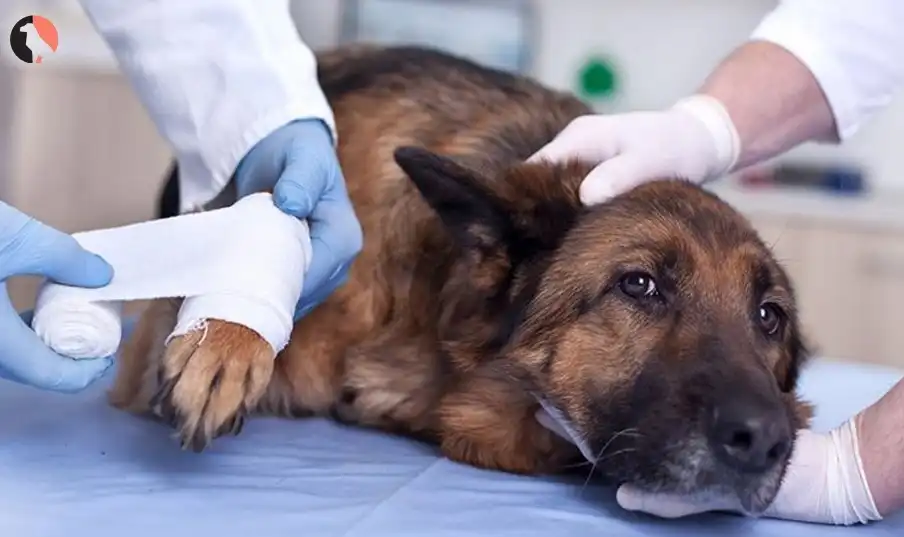Ever known your dog to limp or pretend something hurt, and a few minutes later, he or she can take off running with glee? You are not the only one. The question asked by many dog owners is, Do dogs fake injuries? You can imagine how surprised you would be to find the answer!
Dogs are smart, and they learn fast. They also fake injuries to attract your attention, goodies or to show that they are loved more. This does not imply that they are doing something wrong. It only shows their great knowledge on how to make you react.

But how to understand whether your dog suffers or is only faking? It does not always turn out to be easy to tell. This blog will therefore assist you in knowing the symptoms of fake limping, the causes of it, and how one should act.
So, how do you ensure a happy dog who is also safe in your care and does not take you for a ride?
What is Fake injury in dogs?
We say a dog is faking an injury, and we do not mean that he lies the way people do. Dogs know nothing about telling lies, but can learn that by certain behaviors to make them receive an answer from you.
To illustrate, when your dog is limping, and you lavish some cuddles on it, or give your dog a treat, it could store in its memory and repeat the behavior, even on days when it is not limping.
This type of action is referred to as attention seeking. Dogs are excellent at reading your reactions. They may do it again in case it makes them earn additional love by limping.
However, keep one thing in mind: not every limp is fraudulent. Not all dogs are, in fact, okay. That is why one should be attentive and understand the symptoms.
Reasons Dogs May Fake Injuries
Dogs are not sneaky or bad, and fake injuries. They usually do it because of a very simple reason: to attract attention, love, or to receive a treat. Dogs can pretend to be hurt just as a kid does to miss school or to receive a hug.
The following are some of the most common reasons why your dog may be behaving hurt even though it is fine:
- Additional love: Going to console your dog whenever it is limping might make it memorize the act and repeat it.
- Delicious snacks: On some occasions, some dogs are treated to snacks when they appear sad or limp. It does not take them too long to associate limping with snacks.
- Avoiding something disliked: When your dog pretends to be lame in advance of either a bath or a veterinary appointment, he or she is attempting to avoid the inconvenience.
- Acquired behavior: Dogs are intelligent. Supposing that their artificial walk had served them once, then they might use it again.
One should stay relaxed, though and note the frequency with which it occurs.
The Major Indicators That a Dog Is Lying
But how to get this thing that if your dog is injured or not? The question can only be answered fully by a vet, but some indicators could lead to fake limping or faking an injury.

A few things to look forward to are as listed below:
- Limping alternates: Your dog may be limping here and running there, which may also indicate that they are not in real pain.
- Loss of feeling to touch: Press about the spot where limping takes place as gently as possible. He/she may not be hurt as long as he/she does not flinch or draw away.
- They walk with a limp when you look: A few dogs switch into limping when they notice that you are around, but when they feel that nobody is looking, the act is switched off.
- They continue to play and skip normally: A dog that retrieves, runs, or jumps without any problems may not be hurt.
All these are not necessarily indications that your dog is lying. However, when the limp appears to not correspond or support what they are doing, then they might be doing it in order to gain your attention.
As far as doubts go, always better to consult your vet.
The Difference Between A Real and a Fake Limping
It is sometimes confusing to understand whether the dog is hurt or he/she is fooling you. However, a couple of basic checks are enough to understand it.
Begin by observing them. Do they act in other ways when you are not around and when you are around? The real limping does not occur only when a person is being watched.
A smooth feeling test can then be performed. Using caution, rub your hand around the limping leg or the paw. When your dog starts to pull, cry or feel in pain, then it might be the truth. However, they should remain calm because it can be artificial.
In addition, examine whether they do not step on that leg. Walking, skipping stairs, or refusal to run are also common effects of a true injury in most dogs.
They affect them in a distracted manner, whereby you can see how they behave. Have you tried putting out a toy or treat? If they all of a suddenly forget about the limp, it may not be serious.
It is a good idea to consult your vet; otherwise, it is safer to contact him/her. They will be able to tell you more about what is indeed happening and make your dog feel better.
What to do When You Believe Your Dog is Faking
In case you suspect your dog to be pretending he/she is injured, remain relaxed. It is not because they are being bad, just that they have discovered how to grab your attention through such actions. However, you are supposed to handle it with some seriousness and eliminate the possibility of any actual injury.
The following are what you can do:
- Observe them for several days. Note the time that they limp, and the duration.
- Never pay undue attention or give them additional edibles whenever they limp- unless you are sure that they are injured.
- One of the first things you can attempt to touch is close to the leg or paw softly. When there are no bodily pains or swellings, then it may not be an actual injury.
- Engage them using a toy or a game. There is are high probability that they are all right when they run and play as usual.
And you are still not certain? The next best thing to do is to call your vet. They can detect internal injuries and provide you with the assurance.
When to see a vet
You should take your dog to the vet just to be sure, even in instances that you believe your dog could be lying. Other times, dogs are quite successful with concealing the pain faithfully, and what appears to be acting limping could be the real source of the problem.

These are some signs that you need to call your vet:
- Limping for more than two days
- Inflammation, the reddened skin, or your dog licking one spot repeatedly
- Your dog shows signs of fatigue, debilitation or loss of appetite
- Upon being touched, they cry, whimper, or growl
- The lame one is worse and not better
- A vet can examine your dog softly, provide an X-ray when required and ensure that all is fine. Safe rather than sorry, and heal an actual injury early.
- You must keep in mind that you have a responsibility to take care of your dog. It might be genuine or fake, your attention demonstrates love, and that is everything to your pup.








































































